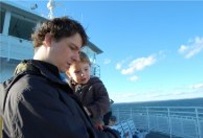Hohn finds Moby Duck

Writer Donovan Hohn (’90) is the 2014 Upper School Book Fair featured author. His book “Moby-Duck” was chosen as a New York Times Notable Book of the Year.
September 30, 2014
Note: This article was originally published in the November 2012 print issue.
Wanted: not the white whale Moby-Dick but the yellow plastic Moby-Duck.
Ever since 12 cargo containers fell overboard during a storm in the Pacific Ocean in 1992, thousands of rubber ducks have been traveling in the largest bathtub of all–the ocean.
Published in 2011, “Moby-Duck: The True Story of 28,800 Bath Toys Lost at Sea and of the Beachcombers, Oceanographers, Environmentalists, and Fools, Including the Author, Who Went in Search of Them,” recounts author Donovan Hohn’s (’90) travels around the globe in pursuit of the elusive plastic duck.
Hohn’s first book was the culmination of years spent devoted to writing.
“I was very bookish in middle school; writing became a serious ambition during my sophomore year. I wrote for The Review and edited the literary magazine,” Hohn said.
Hohn completed an independent study project with his AP English teacher, Maryanne Lyons, when he returned for his senior year.
“I was such an English geek. My spring semester, I wrote 70 pages about 20th-century poetry for the fun of it,” Hohn said.
After graduate school at Boston University, Hohn set out to write fiction. He moved to New York City for his girlfriend, now wife, Beth Chimera, and began an internship at Harper’s Magazine, around the corner from where he tended bar.
“The internship for me was as important as any schooling that I had; it’s what introduced me to journalism and narrative non-fiction,” Hohn said.
While working on “Moby-Duck,” Hohn received the Whiting Writer’s Award in 2008 for non-fiction.
“My book advance was all gone,” Hohn said. “In a state of financial anxiety, I got this magical phone call from the foundation. At first I thought it was a joke. I was overwhelmed to discover it wasn’t. It gave me another year to work on my book.”
Hohn first learned about the bath toy spill in the spring of 2005. He had read a news article reporting on the arrival of the toys on New England beaches.
“I didn’t realize there were container spills, and there was charm in the story. It seemed too good to be true,” Hohn said.
Once Hohn received a map of the bath toys’ route from oceanographer Curtis Ebbesmeyer in Seattle, the book began to take shape.
“I began to imagine, ‘What if I actually did this crazy thing?'” Hohn said.
Hohn’s hunt for Moby-Duck was broken into a series of voyages from the factory that manufactured the bath toys in Guangdong, China, to the site of the spill in the middle of the North Pacific Ocean and then to the High Arctic Ocean.
Hohn recalled one memorable voyage to Gore Point, Alaska. He was offered a ride on a stranger’s homemade boat. The impromptu trip turned out to be a blessing in disguise.
“As a writer, he was a lucky person to end up traveling with,” Hohn said.
The stranger turned out to be Chris Pallister, one of the founders of the Gulf of Alaska Keeper (GoAK), a non-profit organization dedicated to cleaning up the plastic debris that washes up on the Alaskan coast.
Hohn participated in a clean up at Gore Point, an unpopulated and inhospitable area where Pallister and other GoAK members airlifted trash bags filled with flotsam off the coast.
“Pallister, in some ways, had embarked on this grand mission out of devotion to the Alaskan wilderness,” Hohn said. “There are marvelous quantities of flotsam on the coast; to him this was a blight, this was an eyesore, this was pollution.”
Before writing a single word of the novel, Hohn decided on “Moby-Duck” for the title, a play on one of his favorite books, Herman Melville’s classic “Moby-Dick.”
“I took the pun very seriously. The structure of ‘Moby-Dick’ is essentially a hunt for a white whale, but Ishmael is also trying to hunt for an understanding of whales,” Hohn said. “It combines two hunts into one. My book does the same thing.”
While “Moby-Duck” considers environmental questions like the impact of manmade objects on ocean life and what should be done about the problem, it also addresses more philosophical questions.
“In ‘Moby-Dick,’ there’s the symbol of the white whale; similarly, in my book, the symbol is the yellow duck. Where did this icon of childhood come from? Why did it become a symbol of childhood?” Hohn asked.
Hohn is now at the University of Michigan on a fellowship and has begun work on a second book. He divulges that the next book is inspired by the Polish-Soviet War of 1920, and, like “Moby-Duck,” the book will be a travel narrative.
He advises aspiring writers to have patience and to read and learn how to write better.
Hohn said, “I thought I would have a book in my 20s. It took until I was 38.”



